The Apple Thunderbolt Display Review
by Anand Lal Shimpi on September 23, 2011 2:56 AM EST- Posted in
- Displays
- Mac
- Apple
- Thunderbolt
- Thunderbolt Display
Dissection
If you haven't gathered by now, the Thunderbolt Display isn't a regular monitor - it has a lot of components inside that you'd typically only find in a full fledged computer. Being the curious cat I am, I wanted to see inside. Apple isn't too fond of us poking around inside their review samples, but luckily the Crabtree Valley Mall Apple Store just got Thunderbolt Displays in so I hopped in the practical-wagon and grabbed one in the name of science.
Apple has an incredible fascination with using magnets in its designs. What it enables are some pretty neat enclosures, particularly on its displays. The glass front of the Thunderbolt Display is actually identical to what's used on the 27-inch LED Cinema Display and iMac. The glass is held to the chassis via several very strong magnets. To remove the glass you'll need to use suction cups:
Behind the glass front is the actual LCD panel itself. The LCD and backlight are enclosed in a single unit. What we're interested in is behind the LCD however. Unplug a few cables and remove a grounding screw and the LCD unit is easily cast aside. Behind it are two discrete PCBs:
The PCB on the left is the monitor's power supply. Looking at another half-wave rectifier isn't on my to-do list this time, so we turn our attention to the right PCB. This is the board that handles all of the IO on the Thunderbolt Display. All of the screws we've removed thus far just need a T9/T10 torx bit.
The Thunderbolt Display's motherboard is full of controllers driving all of the rear facing IO ports. Contrary to what we originally posted, I now believe this is the same Light Ridge controller we've seen on other Macs (not the MacBook Air):
The external Thunderbolt cable actually continues inside the display and ends up at an internal Thunderbolt port. The cable terminates at the port and then is routed via traces on the PCB to the Eagle Ridge chip:
The other controllers are sprinkled around the PCB, although there's enough space between all of them to make routing nice and easy. The beauty of designing PCBs for monitors like this is you have tons of room to work with.
Pericom provides a PCIe x1 to 4-USB-port adapter on the board:
The internal speakers are driven by a combination of an ST-NXP 0161ET USB audio controller and an Analog Devices ADAV4601 audio processor. The ST-NXP controller sits on an internal USB interface, while the ADAV4601 dangles off of it.
That wraps it up for the front of the PCB. Around back there's a collection of stereo amps as well as the GigE (Broadcom BCM57761) and FW800 (LSI L-FW643E-2) controllers.
There's nothing immediately apparent in the PCB design that would point to the cause of the issue we saw with the Promise Pegasus interfering with the Thunderbolt Display's USB audio controller. The root cause must be exclusive to the Pegasus.








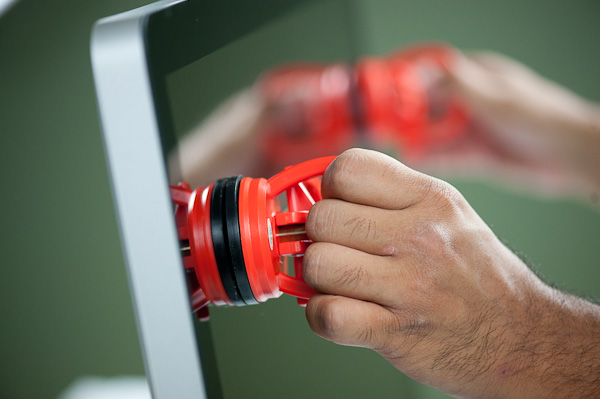
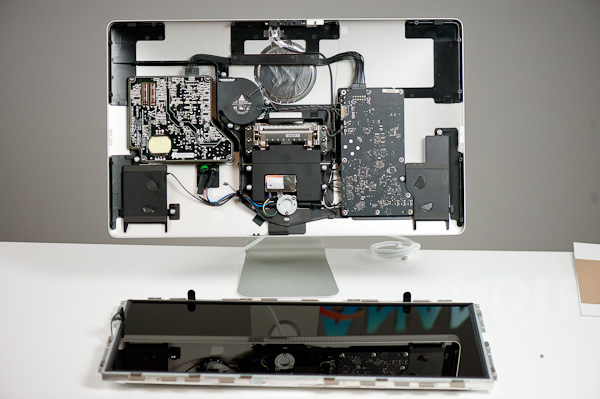
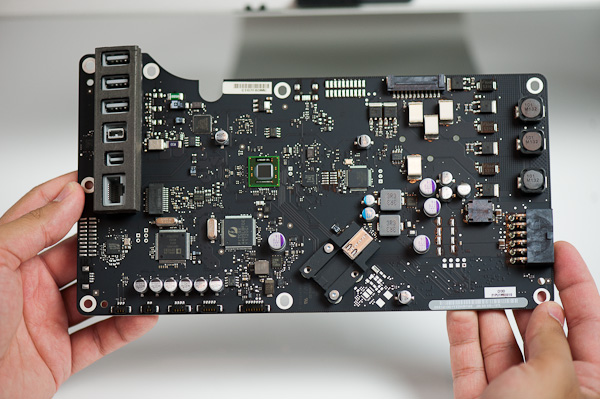
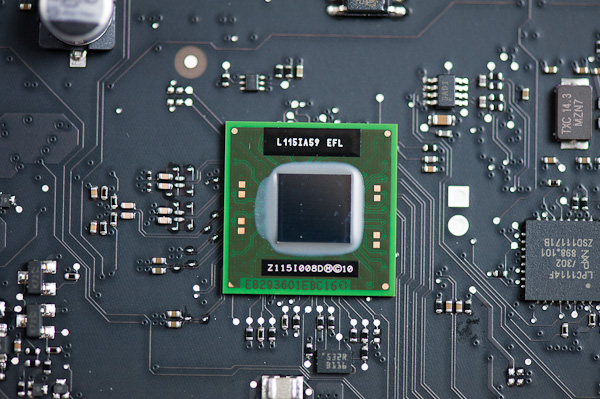
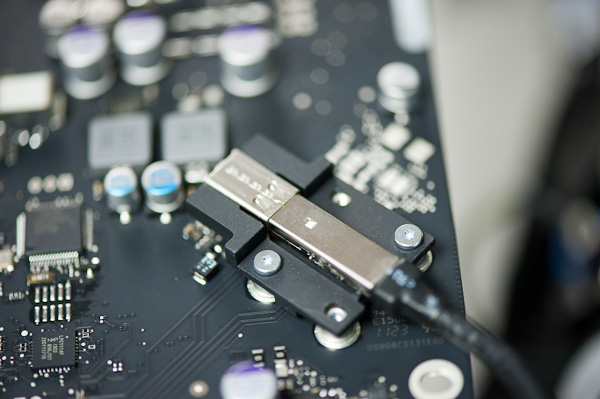
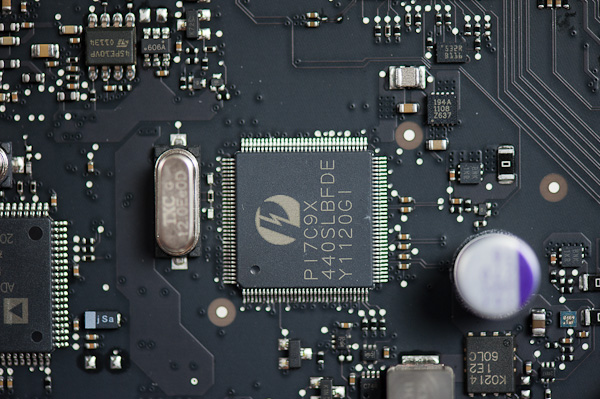
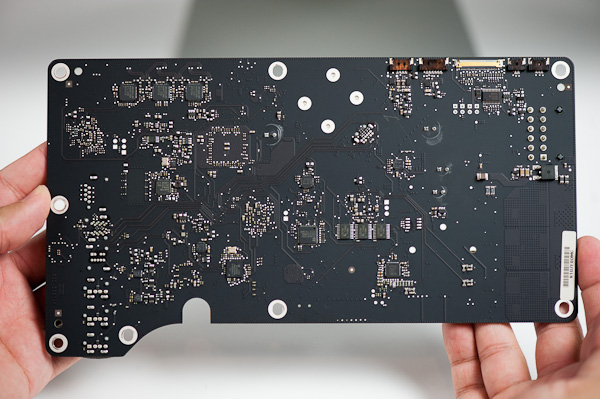
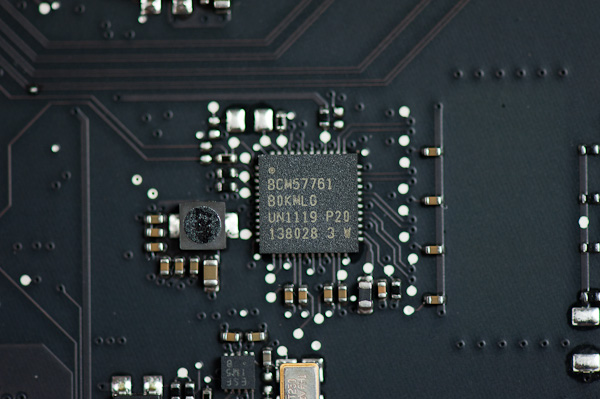








275 Comments
View All Comments
NCM - Friday, September 23, 2011 - link
At under a grand for a giant IPS display that incorporates at least $200 worth of extra connectivity (laptop power supply, T'bolt, additional ports, speakers) this monitor is good value for a MacBook Pro or Air user.Colour accuracy is more than adequate for most professional work. If it's not good enough you should be taking a big step up to something like an Eizo, both shrinking the display size and doubling the price in the process.
jecs - Friday, September 23, 2011 - link
You did read but you just don't understand what color accuracy means or what to do with it.What you call poor color accuracy is the gamut space that is important only if you work with wide gamut color. Apple does not cares for wide gamut, not with this display or with past displays. It does not means the display is not accurate in color, it is very accurate. But Apple optimize their displays for print accuracy were wide gamut is not required. Even for FCP Apple doesn't work with wide gamut. For consumer use wide gamut is also a mixed bag because many complain the color in general looks to bright or "artificial".
I have a 2410 Dell display because I care for wide gamut for what I do but I do appreciate Apple displays and this thunderbolt display is good and other vendors should pay attention to the connectivity and function for desktop use. I would want a mate screen version for more serious professional design but for demanding consumers who appreciate quality and efficiency this is a nice option.
But right now what you need to know is what display is best for what you do.
Are you a professional. Are you a consumer or an aficionado looking for an intermediate option. Or buying the cheapest display.
The Apple displays are for entry level professionals or high end consumers or hobbyist.
For broadcast professional work or for cheap options look else where.
hechacker1 - Friday, September 23, 2011 - link
While I agree with your overall point, I don't think the calibration used by Anand is really informative unless you are doing photo processing work.He's targeting the Adobe 1998 profile, which is great for photo editing and printers that support that target (rare unless in a professional setting).
Most of the Internet is SRGB profile by default, and I'm guessing this display would perform even better there. Most consumer cameras also target SRGB unless you are talking about RAW mode prosumer cameras.
The fact that this display can accurately display most of the Adobe profile bodes well for its accuracy.
If you were in Broadcasting or video editing, you should target Rec. 709 profile, which has completely different gamma curves.
In my opinion, Apple displays are generally very good for the money. Even my late 2009 Macbook Pro can calibrate to excellent color accuracy with VERY little error.
However, my biggest complaint is that lately Apple displays target 6800-6900K color temps, which are too blue for most calibrations and profiles. Sure it looks good to the untrained eye, but it's bad for color accuracy.
jecs - Friday, September 23, 2011 - link
I agree to your more expert opinion than mine.Apple is moving more than ever to the high end consumer or prosumer and the move to the higher kelvin could be another sign. Final Cut X and the price is another example.
But all in all Apple displays are still good monitors.
If you want a very cheap desktop IPS panel Dell also has a new Ultrasharp line with a shorter gamma space and fewer connectors. But there are other cheap options.
Ratman6161 - Friday, September 23, 2011 - link
...that I would not be in the market for a $1000+ display from Apple, Dell or an other manufacturer. What i'm in the market for is the best I can get for $200 - $300. Now, what I can get for my dell is a docking station that comes with an additional power brick for $129.00. So I can get a decent (not great but decent) 22 to 24 inch display + a docking station well within my budget.I guess if a 27" is what you absolutely have to have and you are willing to pay for it, this is a good option...but not for me.
NCM - Friday, September 23, 2011 - link
Which is fine and all, but the fact that you aren't in the market for a monitor in this category is completely irrelevant to the discussion.What's next, that we start posting about our cats?
BrooksT - Saturday, September 24, 2011 - link
Why would you spend $200 on a monitor when you can get a legal pad and pen for $8? I guess if you have to have a computer monitor and you're willing to pay for it, but paper and pen are better options for many people.name99 - Friday, September 23, 2011 - link
Professionals pay for quality tools.Look, if you're earning $100K a year, and this makes you more productive (not to mention happier) it's worth it.
Are you amazed that professional carpenters don't use $5 saws from Target? That professional truckers rig up the insides of their rigs with fancy electronics? That professional musicians buy high quality instruments, not what they can find on Craigslist?
seapeople - Friday, September 23, 2011 - link
You can also buy a $60,000 Cadillac Escalade SUV to pick up your kids at soccer practice.What's your point again?
alphaod - Friday, September 23, 2011 - link
Nice review as usual; very tempted to purchase one, but I think I'm fine with my current setup; already have a power supply I keep plugged in at times.Honestly if Apple added a powerful GPU, yes I think it would a more enticing purchase, but than they'd have the issue of cooling this unit, powering this unit, and constantly upgrade GPUs; at the same time, we'd have people posting online asking all day when the next Thunderbolt GPU updates will come. This would probably also cause problems with pricing; it would come awfully close to the price of an iMac which I'm sure most people would then consider buying an iMac instead (making this product redundant).
Personally I'd prefer if Apple added an optical drive (for those of us who replaced the optical drives in our MacBook Pro notebooks), optical out, better GPU in the display~Hell forget about releasing this display; redo the iMac as a dock for the MacBook Air/Pro!